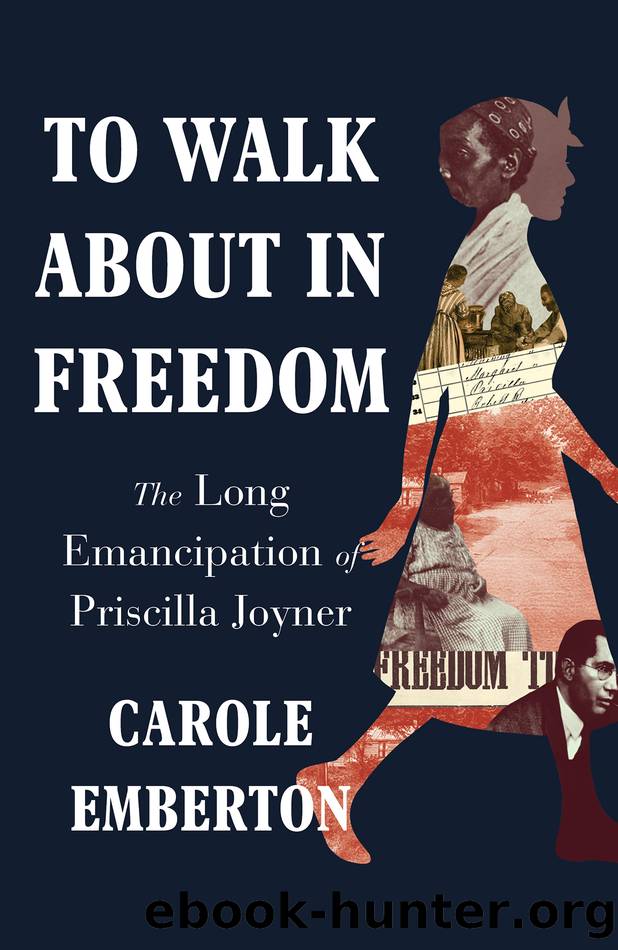To Walk About in Freedom by Unknown

Author:Unknown
Language: eng
Format: epub
Tags: Epub3
Publisher: W. W. Norton & Company
WHEN PRISCILLA AND LEWIS packed up their growing family and left Nash County in 1888 or 1889, they joined the rear guard of a great migration of emancipated people that had begun twenty-five years earlier. While later migrations in the twentieth century would take southern Blacks to northern cities like Philadelphia, New York, Chicago, and Detroit, this earlier migration saw the charter generation move mostly around and throughout the South. With its beginnings in the dislocations of the Civil War, the first Great Migration cracked the foundations of the plantation system and enabled freedpeople to stretch their imaginations as well as their legs. These years witnessed an increase in the Southâs urban Black population. In Union-occupied cities like New Bern, New Orleans, and Atlanta, the presence of federal troops and the creation of refugee camps nearby drew people in from the countryside. Here federal troops handed out rations and offered freedpeople some protection from hostile whites. There was work, too. Freedpeople set up businesses trading, baking, and washing clothes. When large-scale migration to southern towns picked up after the war, whites simultaneously feared the large numbers of Black people congregated together and the depletion of their supply of farm labor in the rural areas.
But town life did not always provide the safety and better living that migrants sought. Although Warren McKinneyâs mother hoped to find work in Augusta, Georgia, she and her young son found mostly sickness and death upon their arrival. McKinney remembered the stacks of coffins nearly eighty years later when he spoke to the FWP interviewer. Although McKinney didnât know it, the cause of all those deaths was most likely cholera. In 1866, an epidemic hit most of the major urban areas in the United States, and even smaller cities like Augusta became a breeding ground for the waterborne intestinal disease. Located on the Savannah River, where many of the migrants washed, defecated, watered their animals, and gathered cooking and drinking water, Augusta was a prime âcholera field.â The tail end of a three-year global pandemic that claimed hundreds of thousands of lives, the 1866 cholera outbreak in the United States staggered a nation still reeling from the Civil War.10
Charter generation migrants reckoned with the unknown and weighed the potential benefits of moving to town against the likely costs. Like those who went before them, the Joyners did not make the decision lightly. By the time they left in 1888 or 1889, Priscilla had given birth to six more children. They needed to be relatively certain that they could quickly put together a functioning household. Like other members of the charter generation, they set out for an urban area that promised better opportunities: Suffolk, Virginia. About a hundred miles from Nash County, Suffolk was home to a number of profitable industries, including shipping and rail transport, oyster packing, and lumber. According to Priscilla, Lewis had been offered a job in a lumberyard, an opportunity he may have found through friends and neighbors who had previously moved there.11
Lewis and Priscilla had likely heard tales of the perils of town life.
Download
This site does not store any files on its server. We only index and link to content provided by other sites. Please contact the content providers to delete copyright contents if any and email us, we'll remove relevant links or contents immediately.
Machine Learning at Scale with H2O by Gregory Keys | David Whiting(3664)
Never by Ken Follett(3550)
Fairy Tale by Stephen King(2973)
The Man Who Died Twice by Richard Osman(2824)
Reminders of Him: A Novel by Colleen Hoover(2781)
Will by Will Smith(2595)
Rationality by Steven Pinker(2159)
It Starts With Us (It Ends with Us #2) by Colleen Hoover(2059)
Friends, Lovers, and the Big Terrible Thing by Matthew Perry(2018)
Can't Hurt Me: Master Your Mind and Defy the Odds - Clean Edition by David Goggins(2012)
The Stranger in the Lifeboat by Mitch Albom(1947)
The Becoming by Nora Roberts(1932)
Love on the Brain by Ali Hazelwood(1828)
New Morning Mercies: A Daily Gospel Devotional by Paul David Tripp(1821)
HBR's 10 Must Reads 2022 by Harvard Business Review(1703)
The Strength In Our Scars by Bianca Sparacino(1702)
A Short History of War by Jeremy Black(1679)
Never Finished: Unshackle Your Mind and Win the War Within by David Goggins(1563)
515945210 by Unknown(1525)
